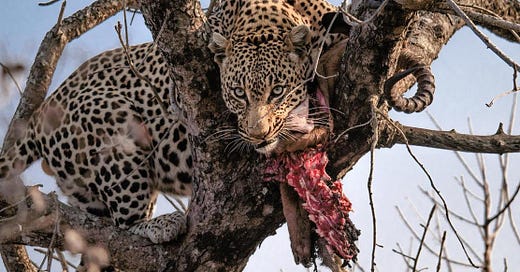by Richard Conniff
(Continued from yesterday’s story)
Flip Stander, who is 38, earned his biology degrees at Cornell and Cambridge universities. But much of his higher education has taken place over the past ten years learning to track with the San. In the city of Windhoek, where he works as the official advocate for leopards, lions and other large carnivores with Namibia's Ministry of Environment and Tourism, he dresses like a trim, bearded park service bureaucrat. But in the field he wore a grimy down jacket, held together with blood stains and duct tape, and a pair of shorts, which revealed that he had scribbled field notes up both legs from knee to cuff. (A bad habit, he said, picked up trying to fly a plane and record sightings at the same time.) He went barefoot everywhere, even on slopes of sharp talus. When he needed to climb a tree, which was often, he grabbed a couple of branches and then walked with almost prehensile feet up the vertical bark.
The tree-climbing was essential for wiring up hunks of springbok and gemsbok as leopard bait. It was grisly work. The blood and guts got set aside to be added to a barrel of gore that had been maturing for more than a year and eight months under a tree back at camp. The trackers used it, ladled out with an old soda can wired to a stick, to make scent trails to lure leopards to bait trees and traps. "It becomes like a perfume," said Stander, both hands fanning the stench up to his connoisseur's nostrils. "The animals don't walk past it. They always stop right there."
The point of all this work was to determine how many leopards were living on a 71,000-acre ranch called Hobatere Lodge and radio-collar them for long-term study. With the trackers, Stander had taken the conventional hunting trick of identifying footprints in the roadbed and turned it into a mathematical technique for estimating the number of leopards per 100 square kilometers (38.61 square miles) of countryside. The trackers could also determine with amazing precision--98 percent accuracy in Stander's study--what each leopard had been doing the night before.
One day, Tkui headed out into the bush, with Txoma walking roughly parallel to him on the road, in pursuit of a big male leopard. "If we're lucky, we'll get it," said Stander. "It's heading straight for the bait."
The trail crossed rough ground, and the two trackers walked thoughtfully, eyes down, hands folded behind their backs. Sometimes they shared a length of copper pipe stuffed with tobacco, too hot for lesser mortals to handle, an upgrade from the traditional pipe made from a steenbok femur. They lost the trail for a time, and fanned out like hounds casting for a scent. Then Tkui whistled and swept his arm to indicate the way ahead, up a dusty riverbed. They crossed the trail of two leopards coming the other way, a mother and her cub perhaps. Stander and the two trackers circled around the trail and traded ideas. The back-and-forth had a slow, cumulative quality, which Stander later described as "trance-like." He broke away reluctantly and said, "This is the male track coming over. So the two leopards are probably from the night before."
"How can you tell the age of the prints?" I asked.
"By the way the wind has eroded them," he said, "and by the superimposed footprints of ants, mice, stuff that moves around."
We followed the deep prints of the male off through the mopani scrub. "The leopard's just gotten the scent," Tkui told us. He could see it in the sharpness of the toe prints. After a few feet more, Tkui crouched, sphinx-like, and peered ahead, mimicking the leopard. The cat had dropped onto its belly, and its forelegs had left long parallel lines in the sand, with the matching lines of the rear legs just behind. "He's looking."
Even I could see the evidence of stalking now, in the way each hind foot had been drawn up slowly and placed almost on top of the forefoot. Then the trail vanished again, and reappeared not at the bait tree but over in the shadow of a hill. The shift made the trackers think the leopard had crossed this way at first light: "When it's pitch dark, a leopard moves in the open. When it's lighter, he favors darker sides, shadowy bits." We crossed the scabby blood stains in the sand, and Tkui touched his nose to indicate the scent trail. But the leopard had walked right past, intending perhaps to wait out the day in some shady spot on the hill. We followed the trail up into a ravine, winding among the rocks and scrubby vegetation, and finally Txoma said, "We'll leave him now." They had the patience of hunters. The bait trees and box traps, cages with trapdoors, would do their work.
(Reminder: This is a story I wrote on a 2001 trip to Namibia and Botswana, so job titles, numbers of animals, and ages of individuals have of course changed. Typically not for the better.)



